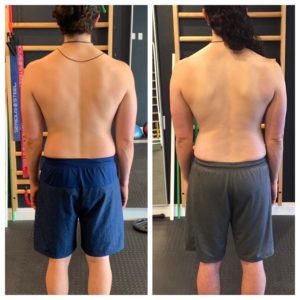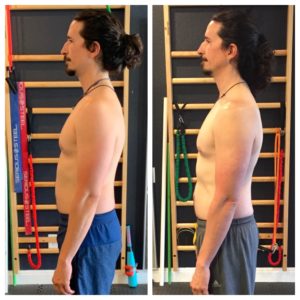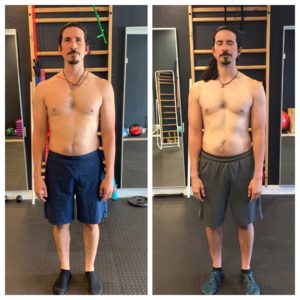My name is Michael, and I am the owner of SA Functional Fitness. I used to think that lifting heavy weight and having big muscles made you strong, it does and it doesn’t. It does make you strong when you lift that particular weight in that particular pattern, however the strength I gained in the gym didn’t translate to reality. The way my body moved when I was in the real world, never represented the way I moved my body in the gym, so that strength in the gym only applied to the gym- never to my lifestyle.
I ended up with various aches and pains in my early 20’s that I wrote off as “no pain, no gain” and continued to do what I thought, at the time, was the correct way to train the human body. As time went on the aches and pains got worse and little injuries started to pop up, first as nagging, then as something that required me to alter my training program and seek traditional methods of healing. I tried chiropractic, massage, physical therapy, cryotherapy, Airrosti, foam rolling, stretching, mobility exercises, body weight training, and more. They all served a purpose toward managing my pain, however nothing truly fixed the underlying issue- I didn’t know how to move well. Poor movement over time started to break my body down due to various compensation patterns I had developed to offset my aches, pains, and injuries.
I finally connected the dots that the way I had trained my entire life was inadequate and what led to my body becoming disconnected, and essentially useless for the way I wanted to live- pain free! It wasn’t solely the heavy lifting, but the exercise patterns that I was moving my body through when I lifted. When the human body moves, at it’s basic function, muscles on one side of the body shorten and muscles on the opposing side of the body lengthen, to propel the body through space. This is called contralateral reciprocation- connecting opposing limbs with each other, right arm/ left leg. It’s easily observed during the most fundamental human movement, walking. When I went to the gym I was squatting, deadlifting, bench pressing, doing isolated muscle work on machines, and ultimately trying to activate individual muscles to make them stronger and balance out the body. None of that worked as I intended. I discovered that muscles can never be isolated, unless your surgically separate them, due to a web that surrounds our body and unites every muscle with each other, called fascia. In other words, when one muscle is working, multiple muscles elsewhere in the body are also working to achieve the intended action. The way I was originally taught to exercise didn’t account for any of that. Over time, my body become out of synch with all the moving parts that make up efficient movement, and little things like walking my dog, playing frisbee, getting in and out of my car, and living life started to become hard because my body wasn’t prepared for the various forces encountered in reality.
These experiences led me to discover a training system called Functional Patterns, that’s geared toward training the human body and the mechanics that compose its various movement patterns, and then getting the body stronger when it moves through those patterns. After employing these new techniques into my training I immediately felt the benefits and saw the logic behind the system. Unfortunately I was still incorporating some of my old traditional exercises into my workouts because I thought it would compliment the new techniques. So some days my body would feel great and then the next day I could be in the same state that caused me to seek out alternative exercises in the first place. Finally I decided to abandon the traditional methods that didn’t serve my function, but only fed my ego and body image. After a few weeks of solely training with the new system I noticed that something felt different. I didn’t wake up with a stiff lower back, my knees didn’t hurt climbing down stairs, and I felt taller, lighter, decompressed, whatever you want to call it, my body felt like it was healing.
At this point, I had been a personal trainer for a few years, peddling out the same exercises to my clients that I had been doing for years. None of my clients complained because, like me, they thought it was all just part of the process. Some were in pain and we’d work on traditional rehab exercises that I had learned from physical therapy, and others just wanted a good workout and we’d work on traditional strength training exercises. Neither instances ever improved my clients pain to the point that it was gone, only diminished for a couple hours or days, nor improved my clients functional strength, only to the point that they could lift heavier dumbbells or more plates on a machine. In fact, my clients who were getting stronger in the gym were starting to complain about little joint aches and muscle twinges that they hadn’t reported when we originally started working together. I knew something was missing but I never had a long term solution to fix their pain or improve their performance without causing minimal amounts of adverse tension. Until I found and experienced the Functional Patterns training system. I decided to start implementing some of the exercises that had helped me and cut out the exercises that I thought were doing more harm than good. Slowly but surely my clients started to feel more lasting relief from their pain and felt better outside of the gym when doing things like playing golf, running errands, and even keeping up with their grandkids. I knew this system was a game changer and I wanted to learn more. I purchased some of their online materials and books to start with and felt my understanding of the human body and movement increase. Then I decided to seek out a practitioner to get training first hand by someone with more experience. My perception of what I thought exercise was about, was crushed- in a good way, and the doors to physical and personal growth opened wide.
At the time I had been working at a local personal training studio, that when I had started, their training methods made sense. But as my body and the bodies of my clients slowly deteriorated I realized that I had to leave the traditional fitness culture behind and spread the knowledge I had acquired to more people. This led me to open SA Functional Fitness to make a lasting impact on helping people move better, without causing pain in the process. Fast forward and I am now a Functional Patterns practitioner, still learning from fellow practitioners that have been incorporating this system longer, and learning from each client that I see. Every body is the same, as we all have the same underlying muscles that are designed to function a particular way, however every body requires different exercises to stimulate the muscles in a way that is going to undo the compensation patterns they’ve gotten themselves into. For example, as humans, we should all have the ability to drive our body forward when we walk by utilizing the glutes, as well as other muscle functions. Sometimes we lose that ability, for various reasons like too much sitting or old injuries, and we end up moving our body with only our calves, or hiking up one of our hips. The muscles must be retrained to activate the glutes during that particular movement, but not by doing squats or clamshells with mini bands, those are the wrong patterns. We teach you the correct movement patterns that are going to engage the glutes and integrate them with the rest of the body, in a fashion that mirrors real life movement, like walking or running. Over time your body will learn to move better at the things you do most, and if you move better, you aren’t victim to aches or pains that develop from improper movement.
Ultimately, if you’re in pain, that’s your body signaling you that it needs help. It’s key to get to the root of the muscle malfunction early before your body starts to move around the pain. Your body will avoid the painful stimulus and adapt your posture and eventually the way you move to allow you to “live” with the pain. We believe that’s no way to live and so we exist to help you find a long term solution to improving your movement- to mitigate pain and improve your posture. If you’ve been living like this for years and years, it’ll take more than a few weeks to undo the damage, but with your hard work and the right techniques, we’ll teach you a recipe to improve your quality of life, and sustain it.













